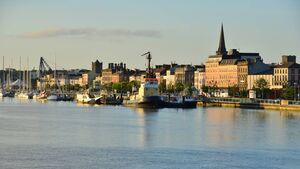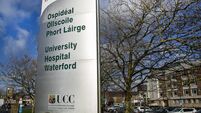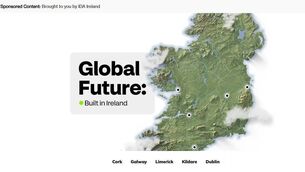Phoenix: Under new management

Leaving larger retailers like Marks & Spencer and Brown Thomas aside, it is extremely hard to understand how shops like New Look, which are ubiquitous around the country, are not in the city.
The recent retirement of council CEO Michael Walsh prompts some heart-searching about where we go next as a city.
Mr. Walsh gave long and diligent service to the city and county. Without him, the North Quays would not be under construction.
We wish him well in whatever he chooses to do next. His heart was in Waterford.
His replacement is Sean McKeown, director of services with Kilkenny County Council, who spent some years as an advisor to Phil Hogan, one-time Minster for the Environment and EU Agriculture Commissioner.
To say that Mr Hogan is not liked in Waterford is an understatement. Closeness to him is a red flag issue in Waterford. Rightly or wrongly people suspect his fingerprints on negative Fine Gael policies that have emerged since 2011, not least in promised investment in UHW and SETU.
Simon Harris counts Mr Hogan among his closest advisors. People in Waterford certainly felt that did not bode well for this city or its investment priorities.
The jury is still out on that, but the time for Mr Harris to honour his investment promises for Waterford SETU and for his government to honour commitments to UHW is tightening rapidly.
Mr McKeown is an able public servant and he must understand how people in Waterford feel. He will also know that his every move will be closely watched.
We will quickly learn how he intends to proceed and the extent to which he will don the Waterford jersey.
It would certainly be a positive were he to live in this city. As in all walks of life, the adage that “by his deeds will we know him” will come into play. Let’s see how it pans out. He has a daunting task ahead of him.
Michael Walsh’s career was marked by Herculean effort to get the North Quays over the line since its designation as a Special Development Zone (SDZ).
In the Dublin docklands SDZ the government formed a special company to carry out the work. In Waterford’s case the project was landed on a council already overburdened and short-handed since the forced amalgamation of city and county in 2014.
Mr Walsh had to focus on the North Quays, but as a result, the historic city centre was to a certain extent ignored and endemic problems allowed to fester.
While the litter problem has been adequately dealt with and conspicuous dereliction is being tackled, council presentation of the city is still not up to par.
Streets like Parnell Street, O’Connell Street and Catherine Street still have masses of overhead utility wires, very poor street lighting and low quality street finishes. Whose responsibility is that?
It is obvious to everyone and Mr McKeown will know this already that the retail offer in Waterford City Centre is below par for a city of its size. A successful urban area, even allowing for internet shopping, needs: disposable income, adequate provision and ease of access, in order to compete.
Questions about disposable income in Waterford have long been raised but there is currently almost full employment.
Many of the better jobs are occupied by people who commute.
Some 40% of jobs in the city are held by commuters.
It is patently obvious that most of the wages and salaries paid to commuters does not find its way back to the city in retail spend.
This dilemma is caused by inadequate provision. Leaving larger retailers like Marks & Spencer and Brown Thomas aside, it is extremely hard to understand how shops like New Look, which are ubiquitous around the country, are not in the city. A similar case could be made for Zara and H&M. The unit size is available in City Square, or was available. Instead the owners have now applied to convert every unit of any size into small individual units. How this will change matters is beyond me. It may actually worsen the situation. Who (in council or Chamber of Commerce) is seeking out and lobbying these retailers? No one?
The elephant in the room is access to the city centre. Everyone talks about traffic on the quays but the situation, subject to personal long-term observation, is that most of the traffic on the quays is caused by people passing through the city, rather than coming into the city.
The supposedly wealthiest part of the city is the Dunmore Road yet it is very difficult to get from there into the city by car or public transport at most times of the day without sitting immobile outside the People's Park in traffic.
Every house that’s built on the Dunmore Road exacerbates the problem. Try getting a bus on time from Abbey Park to the city centre or from Ballygunner to the city centre.
Tramore is a dormitory suburb of the city. How easy is it to get from there by car or public transport to the city centre? Is anyone actually engaging with these issues? What solutions are in the works or posited?
People say that car parking is unavailable or too expensive, yet New Street's 250-space car park is closed, The Glen car park and Railway Square underground are very lightly used. City Square car park has its lower floor closed off regularly. Yet prices for parking remain static.
There is no real competition. A system of electronic noticeboards allied to directional signage, which showed car park vacancy and availability on approaching the city, has been broken and out of use for years. The council simply did not maintain it.
Is anyone in council responsible? A development site in Exchange Street is used as a surface car park, the lowest value use in any urban area, for the past 20 years, with at least 20 planning applications, all without result. The owners have applied again to extend its life as a car park for another two years. The council will again bend the knee.
North Quays or not and they are not the panacea for our endemic problems, the city needs a relentless focus by its incoming chief executive. Mr McKeown please note!






